Contemporary Church History Quarterly
Volume 22, Number 4 (December 2016)
Review of Andrew Chandler, George Bell, Bishop of Chichester: Church, State, and Resistance in the Age of Dictatorship (Grand Rapids, MI: Eerdmans, 2016), Pp. xii + 212, ISBN: 9780802872272.
By Kyle Jantzen, Ambrose University
In George Bell, Bishop of Chichester: Church, State, and Resistance in the Age of Dictatorship, Andrew Chandler grapples with the ecumenical and political legacy of this influential bishop. Beginning with a description of the eclectic contents of one of Bell’s little blue notebooks, Chandler explains how it “captures a mind and a soul in perpetual motion in the world: attentive, enquiring, pursuing. It is a testament of Christian life in the middle twentieth century, wrought out of the turmoil of politics, war, persecution, calamity. It is a proof of one man’s decision to take his place in such a world, and to do so as a faithful Christian” (4).
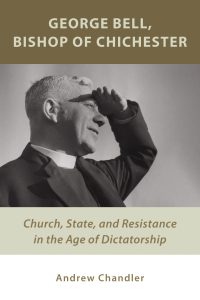 George Bell was born in 1883 on the south coast of England, into a “secure, comfortable middle-class clerical home” (7). He attended Westminster School beginning in 1896, then Christ Church, Oxford, in 1901. Next he enrolled in theological college in Wells, in the West of England, where he was introduced to the student ecumenical movement and to Christian Socialism. Ordained as a deacon in Ripon Cathedral in 1907 and as a priest in Leeds in 1908, Bell returned to Oxford in 1910, where he combined a growing commitment to social justice with a vibrant personal faith. As he explained, “Christianity is a life before it is a system and to lay too much stress on the system destroys the life” (12).
George Bell was born in 1883 on the south coast of England, into a “secure, comfortable middle-class clerical home” (7). He attended Westminster School beginning in 1896, then Christ Church, Oxford, in 1901. Next he enrolled in theological college in Wells, in the West of England, where he was introduced to the student ecumenical movement and to Christian Socialism. Ordained as a deacon in Ripon Cathedral in 1907 and as a priest in Leeds in 1908, Bell returned to Oxford in 1910, where he combined a growing commitment to social justice with a vibrant personal faith. As he explained, “Christianity is a life before it is a system and to lay too much stress on the system destroys the life” (12).
After this overview of Bell’s formative years, Chandler breaks Bell’s ecclesiastical career into a series of chronological chapters which revolve around his positions and causes. Chandler begins with Bell’s time as domestic chaplain to Archbishop Randall Davidson of Canterbury (1914-1924), as dean of Canterbury (1924-1929), and as the newly appointed bishop of Chichester (1929-1932). From there the author examines Bell in his various roles as an interested observer and periodic participant in the German Church Struggle (1933-1937), as an ecumenical leader in a continent hurtling towards war (1937-1939), as a champion of peace in a time of war (1939-1942), as an active supporter of the German Resistance (1942-1945), as a leader in the postwar ecclesiastical reconstruction of Europe (1945-1948), as a key figure in the emergence World Council of Churches (1948-1954), and as an elderly bishop winding down his career (1954-1958).
Throughout these diverse phases of his career, the breadth and volume of Bell’s activities was formidable. Over a span of more than fifty years, he wrote, edited, and contributed to over two-dozen books, ranging from poetry and ecclesiastical biography to credal, incarnational, and pastoral theology, to Christian unity and the relationship between the church and modern politics. Along with his leadership in the Church of England, Bell was a force in numerous international ecumenical institutions, including the World Conference of Life and Work (particularly in Stockholm in 1925 and Oxford in 1937), other ecumenical meetings at Fanö in 1934 and Sigtuna in 1942, the postwar Treysa meeting with German church leaders, and the World Council of Churches, where Bell was elected moderator of the Central Committee at the first WCC assembly in Amsterdam, in 1948.
Bell’s activities were often centred on German affairs. Almost immediately after the rise of Hitler, Bell and his colleague A.S. Duncan-Jones, who was Dean of Chichester, monitored German politics and visited contacts in the German churches, in order to understand the nature of the German Church Struggle for themselves. Bell soon became a critic of the Nazi dictatorship, the pro-Nazi German Christian Faith Movement, and the policy of persecution against both non-Aryan Christians and Jews in general. Around this time, the young Dietrich Bonhoeffer was serving in a German congregation in London, and he and Bell began to develop a warm friendship.
Over the following years, Bell regularly spoke out against the Hitler regime and its supporters within the German churches. When the German delegation failed to appear at the 1937 Oxford Life and Work conference, Bell won support for a letter noting the absence of the German delegation and expressing concern over “the afflictions of many pastors and laymen who have stood firm from the first in the Confessional Church for the sovereignty of Christ, and for the freedom of the Church of Christ to preach His Gospel” (64). After Martin Niemöller’s incarceration in a concentration camp, Bell maintained close contact with the Niemöller family and wrote a stirring foreword for an anonymous biography of the Berlin pastor, in which Bell praised the faith of those standing for the Gospel in Germany. And when the Jewish refugee crisis began to grow acute in 1938, Bell spoke on behalf of refugees in his inaugural speech in the House of Lords, and also lectured publicly about the crisis, describing it as a “crisis of humanity” (69).
Chandler’s description of George Bell’s wartime activities illustrates both the breadth of Bell’s concern and the regularity with which his principled participation in continental political and ecclesiastical affairs pushed him out of step with his peers in the Church of England and British House of Lords. First of all, Bell argued that the church’s role in war was distinct from that of the state. The church was to be a universal body, “charged with a gospel of God’s redeeming love” and tasked with “creating a community founded on love” which would outcast the changes brought about by war (75). Whether in war or in peace, the church, declared Bell, should stand for principles like “the dignity of all men, respect for human life, the acknowledgment of the solidarity for good and evil of all nations and races of the earth, fidelity to the plighted word, and the appreciation of the fact that any power of any kind, political or economic, must be coextensive with responsibility” (75).
Second, Bell worked for peace, championing the vision of a federal union of European states and arguing for negotiation with the German state, even in the midst of the war, in hopes that the Germans would remove Hitler from power. His position was shared by few. Karl Barth felt Bell was “too much a British gentleman and thus unable to understand the phenomenon of Hitler,” while Archbishop Cosmo Lang wrote Bell: “You are an optimist and I am a realist” (81, 82).
In the same way, Chandler shows how Bell’s views on the morality of war were at odds with his contemporaries. When Bell opposed the internment of German and Austrian refugees as enemy aliens in the House of Lords, a fellow member wondered whether the bishop realized England and Germany were at war. When Bell tried to distinguish between Germans and Nazis, he was vigorously opposed in parliament and harangued by a Chichester parishioner. When he protested in the Convocation of Canterbury against the area bombing of German cities, he was shouted down. Worse still, at home in his diocese, he had become so unpopular that Duncan-Jones suggested he not attend a military service at the Chichester Cathedral.
Chandler does an admirable job of explaining the role for which Bell is often best known in German history circles—his activity as secret intermediary between the German Resistance and the British government. In late May 1942, in the city of Stockholm, Bell met with German Pastor Hans Schönfeld of the International Christian Social Institute in Geneva, whom he had known for over a decade. Schönfeld explained that there was a growing opposition movement within Germany, determined to topple Hitler from power and restore the German government to a Christian basis. A few days later, he provided Bell with a list of the names of important conspirators. Just after that, Bell met with Dietrich Bonhoeffer in Sigtuna, Sweden. Bonhoeffer also outlined the nature of the German Resistance, urging Bell to ask the British government for assurances that the Allies would negotiate with the German opposition, if it could seize power. This Bell did, meeting with Foreign Secretary Anthony Eden, but to no avail. Chandler explains not only the government’s skepticism about such “peace feelers,” but also the way in which Bell’s continued lobbying made him suspect and undermined his mission further (100).
After explaining Bell’s determined efforts towards postwar reconciliation and the establishment of the World Council of Churches, Chandler assesses Bell’s legacy in a concluding chapter. There he paints the image of Bell as a man of many interests, causes, and campaigns—indeed, as a man of paradoxes. A member of the Establishment who “did not quite belong to it,” Bell “so often refused to conform to categorical expectations” (166, 170). He was an Anglican with an ecumenical orientation, an Englishman who cared as much or more about international affairs as English matters, and a man of deep devotion who lived large parts of his life in the world of politics. Influenced by high-church incarnational theology, Bell worked to bring art and artists into the life of the church, even as he also exerted himself on behalf of social justice for the working classes and hospitality for Jewish refugees fleeing Nazi persecution (170-171). Most especially, perhaps, he stood for principled and often unpopular positions, such as ecumenical unity and international peace in a time of nationalism and war.
Sadly, no new biography of Bishop George Bell can avoid dealing with the October 2015 allegation that Bell “had committed sexual offenses against an individual who was at the time a young child” (170). Chandler laments the fact that almost everyone associated with this time has passed away, making it virtually impossible to consider the charges in a normal judicial process. He does not in any way deny that these offenses could have occurred, but does the only thing a historian can do, which is to attempt to place the allegations in their historical context. In an appendix devoted to the controversy, Chandler notes that Bell’s 368 volume archive contains his personal notebooks and pocket diaries from 1919 to 1957, in which he kept track of all his appointments and engagements. He notes Bell’s “conspicuously high view of the standards required by his office,” and adds that Bell was almost constantly observed, that he participated in many disciplinary processes for clergy, that he maintained what seemed like a happy marriage, and that he worked almost continually in the presence of his wife, secretary, domestic chaplain, or driver. Chandler interviewed the only member of Bell’s circle still alive, his domestic chaplain from the early 1950s. This man “is firm, indeed emphatic, that ‘no child or young teenager ever entered during my two years as Chaplain, except on the day in January chosen for the parish Christmas party which he and Mrs Bell laid on every year for the children of the clergy’” (198) Add to this that Bell tended to work with his door open and often held private conversations outdoors in the garden and it leads Chandler to describe the 2015 allegation as “anomalous” and seeming to exist “in its own world, evidently uncorroborated by any other independent source” (199).
Andrew Chandler has published widely on the life and ministry of Bishop George Bell, and is the current acknowledged expert on him. George Bell, Bishop of Chichester is a concise, accessible overview of Bell’s engagement in the world of ecumenism and international politics during the turbulent times in which he lived and worked. It deserves a wide readership, especially among those who only know Bell as Bonhoeffer’s friend and English contact on behalf of the German Resistance.

 The exchanges by post or telegrams recorded in these volumes are largely drawn from the Geneva archives of the World Council of Churches or from the voluminous Bell papers, now deposited in the Lambeth Palace library in London. The first volume covers the period up to 1949, and the second the final years of Bell’s life up to 1958. The editing by Gerhard Besier is very helpful, since his footnotes give the biographical details of all persons mentioned, as well as bibliographical references to the many scholarly books relating to their endeavors. (There are, however, aggravating lapses in the proof-reading and printing of the English text.) Besier’s introduction is reproduced from the chapter he contributed to The Church and Humanity: The Life and Work of George Bell, 1883-1958 (p. 169-194), edited in 2012 by Andrew Chandler.
The exchanges by post or telegrams recorded in these volumes are largely drawn from the Geneva archives of the World Council of Churches or from the voluminous Bell papers, now deposited in the Lambeth Palace library in London. The first volume covers the period up to 1949, and the second the final years of Bell’s life up to 1958. The editing by Gerhard Besier is very helpful, since his footnotes give the biographical details of all persons mentioned, as well as bibliographical references to the many scholarly books relating to their endeavors. (There are, however, aggravating lapses in the proof-reading and printing of the English text.) Besier’s introduction is reproduced from the chapter he contributed to The Church and Humanity: The Life and Work of George Bell, 1883-1958 (p. 169-194), edited in 2012 by Andrew Chandler.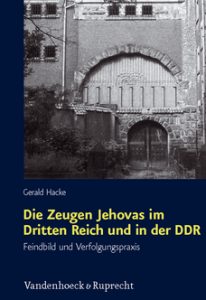 Much of the scholarly literature about the Jehovah’s Witnesses has been conditioned by the harassment and persecution which this sect endured during the period of Nazi rule after 1933. Most of the authors have displayed sympathy with the Witnesses’ sufferings and pay tribute to their enduring loyalty to their faith. Gerald Hacke, however, is principally interested in the actions of the state authorities, and the organization of the various methods of repression which took such a toll. Furthermore he has noted that the same kind of repression was carried out in the post-1945 years in what became known at the German Democratic Republic (GDR) under the aegis of the Communist rulers of that part of Germany for the next 40 years. His large-scale account is therefore mainly a comparison of the similarities as well as the differences in the treatment of this minority religious group by the two ideologically opposed dictatorships. In so doing he has delved in to the vast amount of state documentation left behind by both regimes, particularly in their police and judicial records and the files of the various government ministries who attempted to bring the Jehovah’s Witnesses to heel.
Much of the scholarly literature about the Jehovah’s Witnesses has been conditioned by the harassment and persecution which this sect endured during the period of Nazi rule after 1933. Most of the authors have displayed sympathy with the Witnesses’ sufferings and pay tribute to their enduring loyalty to their faith. Gerald Hacke, however, is principally interested in the actions of the state authorities, and the organization of the various methods of repression which took such a toll. Furthermore he has noted that the same kind of repression was carried out in the post-1945 years in what became known at the German Democratic Republic (GDR) under the aegis of the Communist rulers of that part of Germany for the next 40 years. His large-scale account is therefore mainly a comparison of the similarities as well as the differences in the treatment of this minority religious group by the two ideologically opposed dictatorships. In so doing he has delved in to the vast amount of state documentation left behind by both regimes, particularly in their police and judicial records and the files of the various government ministries who attempted to bring the Jehovah’s Witnesses to heel.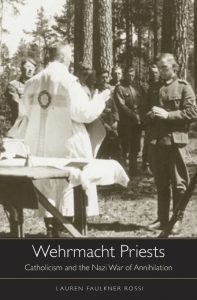 Lauren Faulkner Rossi has produced a measured and original contribution to the serious body of scholarship that has emerged over the past decade or so chronicling the varied responses and experiences of German Catholic priests under Nazism and in the Second World War. Actually, this book is about both ordained clergy and seminarians, an crucial distinction that merits a more precise articulation at the outset of this important study. We are talking here about a subject group that has received comparatively little attention from scholars to date: Catholic priests and seminarians who were conscripted into the Wehrmacht during the Second World War.
Lauren Faulkner Rossi has produced a measured and original contribution to the serious body of scholarship that has emerged over the past decade or so chronicling the varied responses and experiences of German Catholic priests under Nazism and in the Second World War. Actually, this book is about both ordained clergy and seminarians, an crucial distinction that merits a more precise articulation at the outset of this important study. We are talking here about a subject group that has received comparatively little attention from scholars to date: Catholic priests and seminarians who were conscripted into the Wehrmacht during the Second World War. 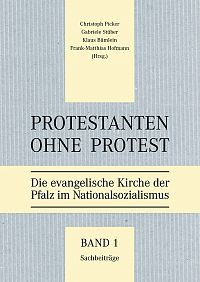 The Protestant Union Church of the Palatinate is one of the smaller regional churches in Germany, with its headquarters in Speyer on the west bank of the Middle Rhine. The church authorities, after lengthy delays, have now published this voluminous collection of essays by more than 60 contributors, which describes the fate of the church during the years of Nazi rule. It constitutes one of the best regional studies of the Protestant church for this period, although, as the chief editor Christoph Picker acknowledges in his introduction, the results are highly sobering. In this region of Germany which was diverse in its denominational loyalties, Protestantism and National Socialism went hand in hand. Many leading Nazi functionaries saw themselves as “good Protestants,” and the collaboration between the church leadership under the “German Christian” Bishop Ludwig Diehl and the Nazi Party’s regional hierarchy was at first close and on very good terms. Above all, the desire among churchmen for stability led them to endorse the Nazi project for “national unity” (Volksgemeinschaft) in the interests of harmony. So no real Church Struggle took place in the Palatinate Church, and it is estimated that 50 percent of the pastors belonged to the German Christian faction in 1933. The limited opposition from those who supported the Confessing Church when it was organized in 1934 was successfully integrated with the dominant German Christians. More than 20 percent of the pastors took out membership in the Nazi Party.
The Protestant Union Church of the Palatinate is one of the smaller regional churches in Germany, with its headquarters in Speyer on the west bank of the Middle Rhine. The church authorities, after lengthy delays, have now published this voluminous collection of essays by more than 60 contributors, which describes the fate of the church during the years of Nazi rule. It constitutes one of the best regional studies of the Protestant church for this period, although, as the chief editor Christoph Picker acknowledges in his introduction, the results are highly sobering. In this region of Germany which was diverse in its denominational loyalties, Protestantism and National Socialism went hand in hand. Many leading Nazi functionaries saw themselves as “good Protestants,” and the collaboration between the church leadership under the “German Christian” Bishop Ludwig Diehl and the Nazi Party’s regional hierarchy was at first close and on very good terms. Above all, the desire among churchmen for stability led them to endorse the Nazi project for “national unity” (Volksgemeinschaft) in the interests of harmony. So no real Church Struggle took place in the Palatinate Church, and it is estimated that 50 percent of the pastors belonged to the German Christian faction in 1933. The limited opposition from those who supported the Confessing Church when it was organized in 1934 was successfully integrated with the dominant German Christians. More than 20 percent of the pastors took out membership in the Nazi Party.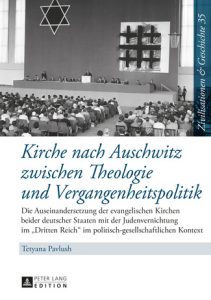 Pavlush focuses primarily on four events: the 1961 trial of Adolf Eichmann and the wave of antisemitism that swept Germany around the same time; the controversy about Rolf Hochhuth’s 1963 play Der Stellvertreter (The Deputy); the 1967 Six-Day War; and the 1979 national broadcast in the FRG of the U.S. television docudrama The Holocaust. In a separate chapter she examines the 1968, 1978, and 1988 anniversaries of the November 9 pogroms (“Kristallnacht”) as indicators of how East and West Germans viewed their history.
Pavlush focuses primarily on four events: the 1961 trial of Adolf Eichmann and the wave of antisemitism that swept Germany around the same time; the controversy about Rolf Hochhuth’s 1963 play Der Stellvertreter (The Deputy); the 1967 Six-Day War; and the 1979 national broadcast in the FRG of the U.S. television docudrama The Holocaust. In a separate chapter she examines the 1968, 1978, and 1988 anniversaries of the November 9 pogroms (“Kristallnacht”) as indicators of how East and West Germans viewed their history.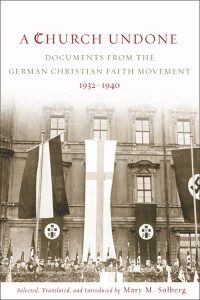 Despite the excellent contributions of such authors as James Zabel, Doris Bergen and Robert Ericksen, Solberg feels that “far too few people in or out of the academy know far too little“ about the conduct of the churches In Hitler’s Germany. But her extended introduction clearly indicates her approach to answering the questions posed by her documents: specifically what role did this German Christian Faith Movement play in the wider picture; how successful or significant were its supporters in the rise and maintenance of Nazism, at least up to 1940; and how should Christians and churches today learn from this example of a church undone? Her skillful translations of the writings of several prominent members of this movement will be of considerable value to those who do not read German, but it would have been helpful to have a biographical note or appendix outlining the careers of these authors. Her conclusion is that this was not a unique episode, that the conflation of political, racist and nationalist ideas with theological witness is a constant temptation, and therefore that the German experience in the 1930s deserves further study by both theologians and historians.
Despite the excellent contributions of such authors as James Zabel, Doris Bergen and Robert Ericksen, Solberg feels that “far too few people in or out of the academy know far too little“ about the conduct of the churches In Hitler’s Germany. But her extended introduction clearly indicates her approach to answering the questions posed by her documents: specifically what role did this German Christian Faith Movement play in the wider picture; how successful or significant were its supporters in the rise and maintenance of Nazism, at least up to 1940; and how should Christians and churches today learn from this example of a church undone? Her skillful translations of the writings of several prominent members of this movement will be of considerable value to those who do not read German, but it would have been helpful to have a biographical note or appendix outlining the careers of these authors. Her conclusion is that this was not a unique episode, that the conflation of political, racist and nationalist ideas with theological witness is a constant temptation, and therefore that the German experience in the 1930s deserves further study by both theologians and historians.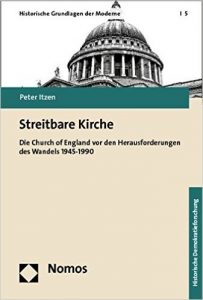 This account pays little attention to theology, but instead follows in the footsteps of such authors as Grace Davie and Callum Brown in emphasizing the sociological patterns he discerns in the Church of England’s development during the fifty years following the Second World War. Itzen lays particular stress on the views and the impact of the major church leaders on the political and social life of the nation, and makes extensive use of the archives held in Lambeth Palace, the residence of successive Archbishops of Canterbury. He also appends short but useful biographical details of many church leaders. The result is a well-informed but not uncritical account of the sometimes controversial stances adopted by the church, and the often critical responses by politicians, for instance during the Suez Crisis in the 1950s, or during Margaret Thatcher’s term as Prime Minister in the 1980s.
This account pays little attention to theology, but instead follows in the footsteps of such authors as Grace Davie and Callum Brown in emphasizing the sociological patterns he discerns in the Church of England’s development during the fifty years following the Second World War. Itzen lays particular stress on the views and the impact of the major church leaders on the political and social life of the nation, and makes extensive use of the archives held in Lambeth Palace, the residence of successive Archbishops of Canterbury. He also appends short but useful biographical details of many church leaders. The result is a well-informed but not uncritical account of the sometimes controversial stances adopted by the church, and the often critical responses by politicians, for instance during the Suez Crisis in the 1950s, or during Margaret Thatcher’s term as Prime Minister in the 1980s. To be sure the tasks of European reconstruction and reconciliation were formidable for politicians and churchmen alike. Priority had to be given to the immense task of caring for the vast millions of bombed-out, brutalized, and displaced populations. Most churches were still tied to their own national affairs and regarded plans for European integration as lying outside their spiritual domain. However a few of the survivors of the pre-war ecumenical bodies, led by the valiant and dynamic personality of the Dutch Calvinist, Visser ‘t Hooft, General Secretary of the World Council of Churches, recognized the importance of seeking closer relations with those politicians involved in European reconstruction. The World Council, which achieved its long-delayed inauguration in 1948, almost immediately suffered a grievous, if not unexpected, blow by the rejection of its invitation to the Vatican to have Roman Catholics as full members. The initiative in European affairs was therefore left to the Anglicans, the Protestant leaders of northern Europe, and a handful of Orthodox churchmen in Eastern Europe. So too, those politicians who had expected that the legacy of unbridled nationalism under Hitler would lead to a willingness to cooperate more closely in pan-European revival were soon to be disappointed by the brusque refusal of the Soviet government to entertain any such measures for the areas of Eastern Europe under its military control. In both the political and religious fields, therefore, expectations had to be cut down, and prognoses for European integration modified, often drastically.
To be sure the tasks of European reconstruction and reconciliation were formidable for politicians and churchmen alike. Priority had to be given to the immense task of caring for the vast millions of bombed-out, brutalized, and displaced populations. Most churches were still tied to their own national affairs and regarded plans for European integration as lying outside their spiritual domain. However a few of the survivors of the pre-war ecumenical bodies, led by the valiant and dynamic personality of the Dutch Calvinist, Visser ‘t Hooft, General Secretary of the World Council of Churches, recognized the importance of seeking closer relations with those politicians involved in European reconstruction. The World Council, which achieved its long-delayed inauguration in 1948, almost immediately suffered a grievous, if not unexpected, blow by the rejection of its invitation to the Vatican to have Roman Catholics as full members. The initiative in European affairs was therefore left to the Anglicans, the Protestant leaders of northern Europe, and a handful of Orthodox churchmen in Eastern Europe. So too, those politicians who had expected that the legacy of unbridled nationalism under Hitler would lead to a willingness to cooperate more closely in pan-European revival were soon to be disappointed by the brusque refusal of the Soviet government to entertain any such measures for the areas of Eastern Europe under its military control. In both the political and religious fields, therefore, expectations had to be cut down, and prognoses for European integration modified, often drastically. Mit Herz und Verstand is one of his recent additions to the literature. In addition to the fine overview of the topic in the introduction by Gailus and co-editor Clemens Vollnhals, it consists of biographical and historical profiles of Agnes and Elisabet von Harnack, Elisabeth Abegg, Elisabeth Schmitz, Elisabeth Schiemann, Margarete Meusel, Katharina Staritz, Agnes Wendland and her daughters Ruth and Angelika, Helene Jacobs, Sophie Benfey-Kunert, Elisabeth von Thadden, and Ina Gschlössl.
Mit Herz und Verstand is one of his recent additions to the literature. In addition to the fine overview of the topic in the introduction by Gailus and co-editor Clemens Vollnhals, it consists of biographical and historical profiles of Agnes and Elisabet von Harnack, Elisabeth Abegg, Elisabeth Schmitz, Elisabeth Schiemann, Margarete Meusel, Katharina Staritz, Agnes Wendland and her daughters Ruth and Angelika, Helene Jacobs, Sophie Benfey-Kunert, Elisabeth von Thadden, and Ina Gschlössl.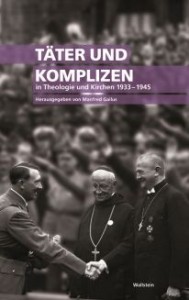 Following Manfed Gailus’ introductory chapter, there are nine chapters (three by Gailus, six by a variety of other scholars) and a theological afterward by Christoph Markschies, church historian, theologian, and former president of Humboldt University. The various chapters link thematically with one another in fruitful ways. Gailus starts things off with an analysis of the Day of Potsdam (March 21, 1933), the day on which Adolf Hitler opened the German parliament in the Garrison Church which had served Prussian monarchs for two hundred years. Drawing on his work in the 2011 book
Following Manfed Gailus’ introductory chapter, there are nine chapters (three by Gailus, six by a variety of other scholars) and a theological afterward by Christoph Markschies, church historian, theologian, and former president of Humboldt University. The various chapters link thematically with one another in fruitful ways. Gailus starts things off with an analysis of the Day of Potsdam (March 21, 1933), the day on which Adolf Hitler opened the German parliament in the Garrison Church which had served Prussian monarchs for two hundred years. Drawing on his work in the 2011 book  Colchester’s social elite, which was well represented in the Church of England parishes, was conservative, nationalist and hierarchical. Its members supported the British government’s decision to go to war in August 1914 for moral as well as political reasons. They joined in the widespread campaign urging young men to join the armed forces, until conscription was introduced in 1916, rendering such appeals superfluous. Thereafter the leading men set an example by supporting campaigns for contributions to the War Savings Bonds, while the church ladies were very active in ministering to the troops training in Colchester and to the wounded. Church people were assiduous in providing hospitality to the troops, and at least thirty five social clubs were established where recreational facilities and food were supplied, often at little cost. In part such provision was seen as a Christian virtue, but, as Beaken notes, in part it was inspired by the desire to keep the soldiers out of public houses, and so to keep prostitution and its attendant problems at bay.
Colchester’s social elite, which was well represented in the Church of England parishes, was conservative, nationalist and hierarchical. Its members supported the British government’s decision to go to war in August 1914 for moral as well as political reasons. They joined in the widespread campaign urging young men to join the armed forces, until conscription was introduced in 1916, rendering such appeals superfluous. Thereafter the leading men set an example by supporting campaigns for contributions to the War Savings Bonds, while the church ladies were very active in ministering to the troops training in Colchester and to the wounded. Church people were assiduous in providing hospitality to the troops, and at least thirty five social clubs were established where recreational facilities and food were supplied, often at little cost. In part such provision was seen as a Christian virtue, but, as Beaken notes, in part it was inspired by the desire to keep the soldiers out of public houses, and so to keep prostitution and its attendant problems at bay.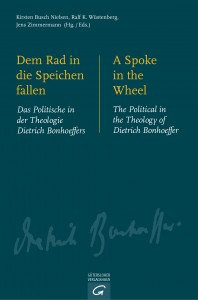 Some of the highlights of the collection include the lead essay by Wolfgang Huber in which he provides a theological profile of Bonhoeffer’s political resistance, particularly his involvement in Hans von Dohnanyi’s conspiracy in the Abwehr. Despite the limitations placed on what Bonhoeffer could put into writing during the Third Reich, Huber believes a “theology of resistance” can be teased out of Bonhoeffer’s writing during this time. His call for the Church to take a public stand in solidarity with the Jews against the repressive state; his formulation of a confession of guilt in the name of the church; his theory of a responsible life; and his trust in God’s guidance—all indicate the rudiments of a theology of resistance, Huber believes.
Some of the highlights of the collection include the lead essay by Wolfgang Huber in which he provides a theological profile of Bonhoeffer’s political resistance, particularly his involvement in Hans von Dohnanyi’s conspiracy in the Abwehr. Despite the limitations placed on what Bonhoeffer could put into writing during the Third Reich, Huber believes a “theology of resistance” can be teased out of Bonhoeffer’s writing during this time. His call for the Church to take a public stand in solidarity with the Jews against the repressive state; his formulation of a confession of guilt in the name of the church; his theory of a responsible life; and his trust in God’s guidance—all indicate the rudiments of a theology of resistance, Huber believes. Pollard has an imposing pedigree, which one might demand of a scholar willing to tackle such a contentious subject: he is no amateur in examining modern popes in times of conflict. He has devoted much of his professional career to the Vatican and Catholicism in Fascist Italy, and his biography of Benedict XV is one of the most significant of any language. His introduction includes several crucial definitions and a brief sketch of the papacy up to Benedict’s election in September 1914. His conclusion speaks cogently of the legacy of the period as a whole, which he refers to simply as the age of totalitarianism, and addresses its greatest legacy: bringing the divisions between Church conservatives and liberals to the fore, leading to the most radical changes in Church history at the Second Vatican Council (478).
Pollard has an imposing pedigree, which one might demand of a scholar willing to tackle such a contentious subject: he is no amateur in examining modern popes in times of conflict. He has devoted much of his professional career to the Vatican and Catholicism in Fascist Italy, and his biography of Benedict XV is one of the most significant of any language. His introduction includes several crucial definitions and a brief sketch of the papacy up to Benedict’s election in September 1914. His conclusion speaks cogently of the legacy of the period as a whole, which he refers to simply as the age of totalitarianism, and addresses its greatest legacy: bringing the divisions between Church conservatives and liberals to the fore, leading to the most radical changes in Church history at the Second Vatican Council (478). Kornberg takes on both sides of the Pius War, questioning the various ways in which scholars have sought to either support Pius’s reactions to the Nazi regime or have tried to find fault with Pius’s response (or lack thereof). At the book’s outset, Kornberg asks the fundamental question that has frustrated both sides of the scholarly debate: “why was the pope unable to deal with radical evil?” (3) Kornberg argues that, in his view, the papacy of Pius XII was a moral failure out of “calculated acquiescence;” meaning that the pope willingly allowed Nazi atrocities to happen “because of his own priorities and responsibilities as head of the Roman Catholic Church” (8-9). Kornberg then tracks how Pius’s reputation drastically plummeted in the 1960s, in no small part to the wildly successful play by Rolf Hochhuth, Der Stellvertreter, (The Deputy) which depicted a cold, calculating Pius who sat silent in the face of Nazi crimes for “reasons of state” (16). With this incendiary play, debates raged: was Pius complicit with the Nazi regime due to his silence or was Hochhuth’s play no more than a deeply flawed portrayal of the Pope? Kornberg takes the reader through the play, the reactions and counter-reactions to it and links this to the role of Vatican II in further sealing the demise of Pius’s reputation. A new era was opening up for the Church under the leadership of the charismatic and charming Pope John XXIII and Kornberg dryly notes that in this new climate, “it was inevitable that Pius XII’s reputation would sink like a stone” (35). At issue here was the question of mission: what was the Catholic Church’s role? Was it to serve as a voice of morality to the world, was it to concern itself primarily with pastoral care, or was it to be a mixture of both of these? Raising these questions allows Kornberg to move on to his next chapter, addressing the options of Eugenio Pacelli and his role in the drafting of the Reichskonkordat.
Kornberg takes on both sides of the Pius War, questioning the various ways in which scholars have sought to either support Pius’s reactions to the Nazi regime or have tried to find fault with Pius’s response (or lack thereof). At the book’s outset, Kornberg asks the fundamental question that has frustrated both sides of the scholarly debate: “why was the pope unable to deal with radical evil?” (3) Kornberg argues that, in his view, the papacy of Pius XII was a moral failure out of “calculated acquiescence;” meaning that the pope willingly allowed Nazi atrocities to happen “because of his own priorities and responsibilities as head of the Roman Catholic Church” (8-9). Kornberg then tracks how Pius’s reputation drastically plummeted in the 1960s, in no small part to the wildly successful play by Rolf Hochhuth, Der Stellvertreter, (The Deputy) which depicted a cold, calculating Pius who sat silent in the face of Nazi crimes for “reasons of state” (16). With this incendiary play, debates raged: was Pius complicit with the Nazi regime due to his silence or was Hochhuth’s play no more than a deeply flawed portrayal of the Pope? Kornberg takes the reader through the play, the reactions and counter-reactions to it and links this to the role of Vatican II in further sealing the demise of Pius’s reputation. A new era was opening up for the Church under the leadership of the charismatic and charming Pope John XXIII and Kornberg dryly notes that in this new climate, “it was inevitable that Pius XII’s reputation would sink like a stone” (35). At issue here was the question of mission: what was the Catholic Church’s role? Was it to serve as a voice of morality to the world, was it to concern itself primarily with pastoral care, or was it to be a mixture of both of these? Raising these questions allows Kornberg to move on to his next chapter, addressing the options of Eugenio Pacelli and his role in the drafting of the Reichskonkordat.